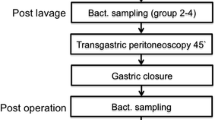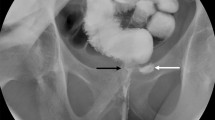Abstract
Background. The use of radiographic contrast media in the setting of possible bowel ischemia and potential perforation is known to be associated with increased clinical risk. However, there is a lack of controlled studies using a standard native fecal load to define and compare the intrinsic mortality and morbidity among options of contrast media currently available to the radiologist. We have compared the mortality and gross and histopathologic morbidity of a standard intraperitoneal native fecal dose in the guinea pig, using barium, two iodinated media, saline and air.¶Materials and methods. The study was performed on adult Hartley guinea pigs. A standard native fecal solution with a colony count of 108 aerobes and 2 × 107 anaerobes was prepared, and the LD50 of intraperitoneal injection of the solution was determined. The standard solution at the LD50 dose was then used to compare the mortality and morbidity when commercial barium sulfate (18 % w/v), Conray 30 (iothalamate meglumine 30 %), 1:1 dilution of Conray 30 with sterile water, termed Conray “15” (iothalamate meglumine 15 %), saline and air, were added to the intraperitoneal injection of the fecal solution in five groups of 20 animals each. Mortality and acute (96 h) and chronic (30 days) gross and histopathology were assessed and graded according to a standard system and analyzed statistically.¶Results. Barium was significantly more deleterious than the dilute water-soluble iodinated media, saline and air. Mortality occurred within 24 h in the barium group and within the initial 48 h in all groups as follows: barium 19/20 (95 %); Conray 30 16/20 (80 %); Conray “15”¶7/20 (35 %); saline 0; air 0. Acute gross and histopathology showed extensive grade 4 lesions in 19/19 barium animals; less severe lesions were present in a lesser percentage of the animals in the other four groups. Entirely chronic lesions were present only in the single surviving barium animal and were non-significant (<400 μm) or absent in the other four groups.¶Conclusions. In our study, barium incurred the most significant deleterious short and long-term effects in the setting of fecal peritonitis. Dilute water-soluble media offer a much greater margin of safety. Saline under sonographic guidance is less deleterious than any of the positive radiographic contrast media. However, in our study, air was the safest contrast medium in the setting of peritoneal soiling.
Similar content being viewed by others
Author information
Authors and Affiliations
Additional information
Received: 19 July 1999/Accepted: 4 November 1999
Rights and permissions
About this article
Cite this article
Hernanz-Schulman, M., Foster, C., Maxa, R. et al. Experimental study of mortality and morbidity of contrast media and standardized fecal dose in the peritoneal cavity. Pediatric Radiology 30, 369–378 (2000). https://doi.org/10.1007/s002470050764
Issue Date:
DOI: https://doi.org/10.1007/s002470050764




